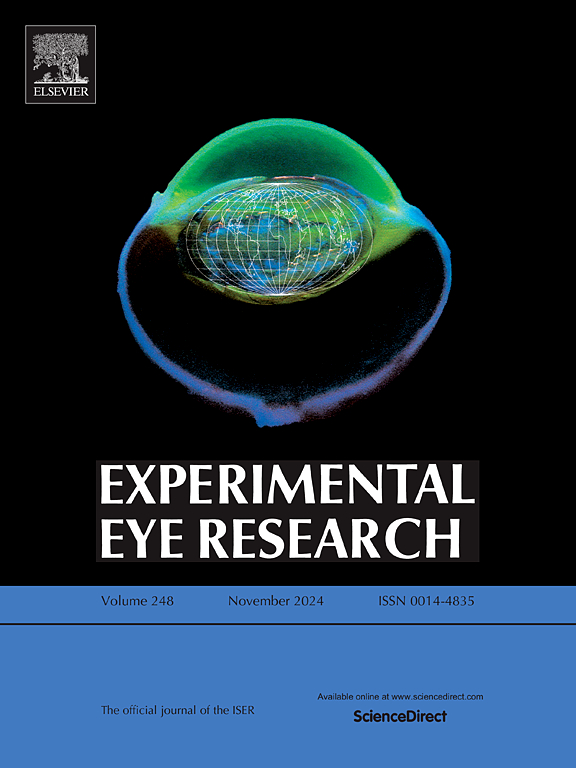Integration of proteomics and artificial intelligence-driven OCT biomarker analysis in central retinal vein occlusion
IF 3
2区 医学
Q1 OPHTHALMOLOGY
引用次数: 0
Abstract
Retinal OCT biomarker analysis by artificial intelligence (AI) has not previously been integrated with proteomics. Here, we combined the two techniques to elucidate novel molecular mechanisms in central retinal vein occlusion (CRVO). Proteomic data on aqueous humor samples from patients with treatment naïve CRVO complicated by macular edema (n = 21) and an age-matched, healthy control group (n = 20) was obtained from an existing cohort. Swept-source OCT macular scans (Topcon) from CRVO patients were analysed by AI-driven OCT software (Discovery platform, RetinAI AG, Bern Switzerland) to quantify retinal thicknesses and OCT biomarkers, including intraretinal fluid (IRF), subretinal fluid (SRF), and the outer nuclear layer thickness (ONL). Correlation analysis between protein expression and OCT biomarkers was performed. Proteins involved in complement activation and immune responses exhibited positive correlations with IRF, notably complement component C8 beta chain (r = 0.63, p = 0.0020) and Ig lambda-6 chain C region (r = 0.59, p = 0.0050). Negative correlations with IRF were identified for phosphatidylethanolamine-binding protein 1 (r = −0.66, p = 0.0010) and chordin-like protein 1 (r = −0.61, p = 0.0030). SRF was linked with insulin-like growth factor-binding protein complex acid labile subunit (r = 0.55, p = 0.010) and with extracellular superoxide dismutase (r = −0.63, p = 0.0022). Retinal layer thickness, particularly ONL and total retinal thickness, was positively associated with fibrinogen beta chain (r = 0.58, p = 0.0060) and fibronectin (r = 0.51, p = 0.019). The integration of AI and proteomics allowed for linking biological processes with specific OCT biomarkers. The combined analysis identified complement activation, immune response, oxidative stress, and extracellular matrix remodelling as likely driving forces of macular edema secondary to CRVO.
蛋白质组学与人工智能驱动的OCT生物标志物分析在中央静脉视网膜闭塞中的整合。
人工智能(AI)的视网膜OCT生物标志物分析以前尚未与蛋白质组学相结合。在这里,我们结合这两种技术来阐明视网膜中央静脉阻塞(CRVO)的新分子机制。从现有队列中获得naïve CRVO合并黄斑水肿患者(n = 21)和年龄匹配的健康对照组(n = 20)房水样本的蛋白质组学数据。通过人工智能驱动的OCT软件(Discovery平台,RetinAI AG, Bern Switzerland)分析CRVO患者的扫描源OCT黄斑扫描(Topcon),以量化视网膜厚度和OCT生物标志物,包括视网膜内液(IRF),视网膜下液(SRF)和外核层厚度(ONL)。进行蛋白表达与OCT生物标志物的相关性分析。参与补体活化和免疫应答的蛋白与IRF呈正相关,特别是补体组分C8 β链(r=0.63, p=0.0020)和Ig λ -6链C区(r=0.59, p=0.0050)。磷脂酰乙醇胺结合蛋白1 (r=-0.66, p=0.0010)和弦样蛋白1 (r=-0.61, p=0.0030)与IRF呈负相关。SRF与胰岛素样生长因子结合蛋白复合物酸不稳定亚基相关(r=0.55, p=0.010),与细胞外超氧化物歧化酶相关(r=-0.63, p=0.0022)。视网膜层厚度,特别是ONL和视网膜总厚度与纤维蛋白原β链(r=0.58, p=0.0060)和纤维连接蛋白(r=0.51, p=0.019)呈正相关。人工智能和蛋白质组学的整合允许将生物过程与特定的OCT生物标志物联系起来。综合分析发现,补体活化、免疫反应、氧化应激和细胞外基质重塑可能是CRVO继发黄斑水肿的驱动力。
本文章由计算机程序翻译,如有差异,请以英文原文为准。
求助全文
约1分钟内获得全文
求助全文
来源期刊

Experimental eye research
医学-眼科学
CiteScore
6.80
自引率
5.90%
发文量
323
审稿时长
66 days
期刊介绍:
The primary goal of Experimental Eye Research is to publish original research papers on all aspects of experimental biology of the eye and ocular tissues that seek to define the mechanisms of normal function and/or disease. Studies of ocular tissues that encompass the disciplines of cell biology, developmental biology, genetics, molecular biology, physiology, biochemistry, biophysics, immunology or microbiology are most welcomed. Manuscripts that are purely clinical or in a surgical area of ophthalmology are not appropriate for submission to Experimental Eye Research and if received will be returned without review.
 求助内容:
求助内容: 应助结果提醒方式:
应助结果提醒方式:


